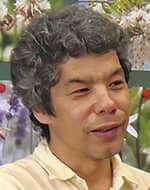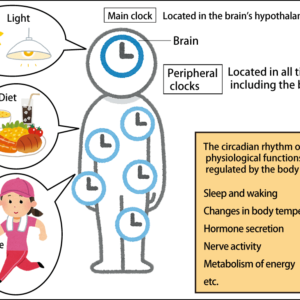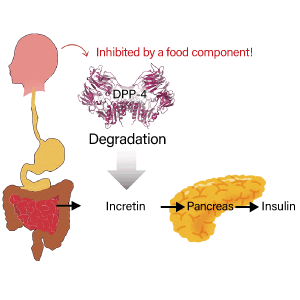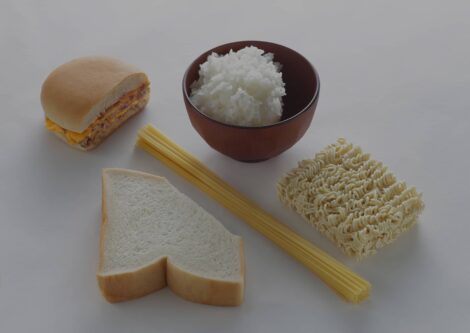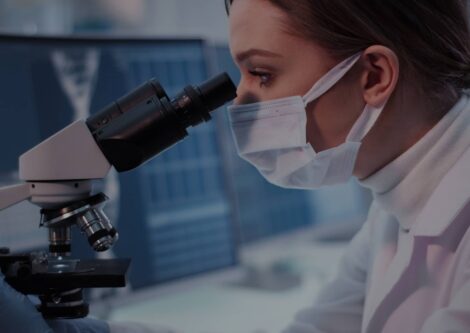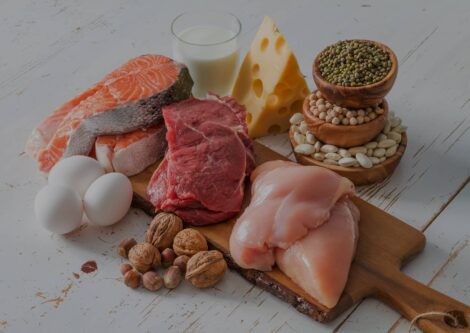Honeybee products have been a familiar part of people’s daily lives since ancient times. Most notable among them is honey, which has a high sugar content and is often used as a sweetener in drinks and in cooking. Additionally, honey is rich in minerals and has an antibacterial effect, so it is also used as a preserved food. Another honeybee product is royal jelly, which is fed solely to queen bee larvae. Containing a high level of protein, as well as certain fatty acids, royal jelly is very nutritious and is not only added to health foods, but also to cosmetics as a moisturizing ingredient. With a lineup that also includes propolis and beeswax, the blessings of honeybees are bountiful indeed.
Special Feature 1 – The World of Honeybees More than just honey! The diversity of honeybee products
composition by Yuko Watanabe
Honeybees gather nectar and pollen from plants to use as their food. They can obtain sugars from nectar, while pollen provides protein and other nutrients. Honeybees also gather resin and exudates secreted by plants to protect their buds. The various substances produced by honeybees from the raw materials of nectar, pollen, and resin have been used in daily life by humans since ancient times (Figure 1).

Figure 1. Honeybee productsHoneybee products can be classified on the basis of the raw materials gathered by worker bees, from which they are produced: nectar, pollen, and resin. Japan is reliant on imports for most of these, including honey. In addition, pollination is a key function that supports our diet.
Condensed to reach a sugar content of around 80%
Let us first look at how honey is produced. Worker bees fly around visiting numerous flowers to gather nectar, which they store temporarily in a digestive organ called a honey stomach (also known as a honey sac). Upon returning to the hive, they transfer all the nectar mouth-to-mouth to worker bees on storage duty, which then store the nectar in cells in the hive. Nectar’s specific components depend on the species of the flower, but in the main, it consists of sucrose, fructose, and glucose. It also contains minerals —— the higher the mineral content, the darker the color and the richer the flavor. When storing the nectar in cells, worker bees on storage duty add enzymes that break sucrose down into fructose and glucose. In addition, the drafts of air produced when worker bees fan their wings to ventilate the hive are used to get rid of moisture, condensing the nectar until it reaches a sugar content of around 80%. The mature honey not only serves as the day-to-day food of worker bees, but is also used as a preserved food to help the bees get through winter.
Worker bees forage within a radius of 2-3 km of their hives, although they may fly long distances —— in excess of 6 km —— if good resources are available. What is more, they can carry nectar and pollen weighing as much as 40 mg —— almost half their bodyweight. A single colony of honeybees (equivalent to a beehive composed of one queen bee and around 30,000 worker bees) is said to require 120 kg of nectar per year as a source of sugar. They can produce 6 kg of honey from 10 kg of nectar, which means that if, for example, the whole 120 kg of nectar was turned into honey, the result would be around 70 kg of honey, 10-20 kg of which would provide the stockpile required to get through winter.
According to data published in November 2022 by the Livestock Industry Bureau of the Ministry of Agriculture, Forestry and Fisheries, the volume of honey distributed to the Japanese market in 2021 was approximately 50,000 tons (t). Of this, domestically produced honey accounted for around 2,700 t (about 5%), almost all of which is consumed by households. Accounting for 95% of all honey reaching the Japanese market, imports of honey total approximately 47,300 t, around 30,000 t of which is produced in China. Approximately 28,400 t (about 60%) of imported honey is consumed by households, with the remaining 18,900 t or so being used in the manufacture of food and cosmetics.
- * 1 ton = 1,000 kg
The color, flavor, and scent of honey differ according to the flowers from which the nectar was gathered, and enjoying these differences is one part of honey’s appeal (Figure 2). People’s preferences vary: whereas the familiar acacia honey (derived from the false acacia, which is more commonly known as black locust (Robinia pseudoacacia)) is virtually transparent, with a fairly weak scent, Japanese chestnut (Castanea crenata) honey and buckwheat (Fagopyrum esculentum) honey are both dark reddish-brown, with a strong scent. At one time, we rented a field for the purpose of beekeeping research in Wakayama Prefecture, where nectar is collected from satsuma mandarin (Citrus unshiu) blossom. The honey we obtained from this was exceptionally good: the moment you opened the lid of the jar, you were surrounded by the scent of mandarin blossom, almost as though you were in a mandarin orchard in full bloom.

Figure 2. Types and colors of honeyDepending on the sources of nectar visited by forager worker bees, the colors, flavors, and scents of honey vary considerably, from almost transparent acacia (left) to virtually black buckwheat (right). In Japan, the most common is honey produced from a natural blend of multiple nectar sources, which is called “multiflora honey.”
Adding honey increases shelf life
Returning to the topic of honey consumption, the volume of honey consumed just does not seem to increase, even though we spread it on bread for breakfast or use it to sweeten our tea. You have probably experienced for yourself the way a jar of honey seems to last forever. Whereas the principal component of granulated sugar is sucrose, which has a uniform level of sweetness, honey’s sweetness has greater depth, as it contains fructose and glucose, in addition to sucrose and maltose. It occurred to me that if we tapped into honey’s richness as a sweetener by using it in baking and other forms of cooking to make food taste even better, and thereby make people more aware of its appeal, it might lead to an increase in honey consumption. Accordingly, I am working with students in the Department of Advanced Food Sciences at Tamagawa University’s College of Agriculture on creating confectionery in which you can taste the honey’s true flavor (Figure 3). Based on the premise of home-made sweet treats, we are examining how many jars of honey can be consumed in this way. I will note that we are disregarding cost in this study.

Figure 3. A trial of making cookies with different types of honeyCookies in which part of the sugar was replaced with honey. From left: granulated sugar only, acacia honey, chestnut honey, false indigo honey, and buckwheat honey.
In the confectionery-making process that the students are researching, we have simply been replacing part of the sugar in ordinary recipes for cakes, cookies and the like with honey. While this does improve the flavor, we have found it hard to produce the desired results, as the scent of the honey disappears or the honey’s original color does not come out in the finished product. As such, we believe that further creative adjustments will be required.
Honey also has antibacterial effects, so the students are conducting a study to find out how using honey in cooking changes the flavor of food and the extent to which its use curbs the proliferation of bacteria. Conducting experiments with white rice, omelet, and a meat-based dish, the students have found that in the case of omelet, which does not keep well, adding honey slightly increases how long it keeps before decaying. We are continuing these experiments with other foods, in the hope that we will be able to contribute to increasing the volume of honey consumption.
Honey also has a long history of use as a medicine. Even in Japan, the Japanese Pharmacopoeia states that honey is effective as a nutrient and a sweetener, and for healing cracked or chapped lips. In addition, honey has been used in clinical trials of treatments for burns and persistent diabetic ulcers.
Beeswax comes from wax scales secreted from wax glands in worker bees’ abdomens, after being synthesized within the bees’ bodies from the sugars in honey. Worker bees are said to need at least 6 g of honey to synthesize 1 g of wax scales. Worker bees chew up these wax scales and combine them with their saliva to build their hives. Old hives are collected, melted down, and refined to make beeswax. The resultant beeswax is mainly used to produce items such as candles, wax polish, cosmetics, and crayons, and is also frequently utilized in the manufacture of food and as a mold release agent for industrial goods. As domestic production of beeswax is low, at around 19 t in 2021, Japan is almost entirely reliant on imports.
Pollen is gathered from flowers by worker bees called foragers. These foragers dexterously use brush-like structures on their legs to scrape off pollen that has stuck to the hairs on their body; when necessary, they will mix it with honey to form granules known as bee pollen, which they place in the pollen baskets (corbiculae) on their hind legs to carry back to the hive. After foragers put the bee pollen into cells, worker bees in charge of storage use their heads to pack it deep into the cells, mixing it with more honey so that it can be stored as bee bread.
Used as an ingredient in the production of the milk fed to larvae and royal jelly for the queen bee, the stored pollen is eaten by the young worker bees in charge of raising the larvae. A single colony of honeybees is said to gather around 50 kg of pollen per year, which equates to the quantity that can bring up 150,000 worker bees. Pollen is a source of protein, but its protein content varies widely from 6-28%, depending on plant species. It is thought that honeybees have a strong tendency to use multiple species of plants, in order to make up for this variation in nutritional value (Figure 4).

Figure 4. A forager visiting a canola blossom, and bee pollen<Top> A forager gathering nectar and pollen. Pollen clusters can be seen on its rear leg.
<Bottom> Many plants bloom in spring, and in just three hours or so, the bees brought back bee pollen in more than 10 different colors.
When we use the pollen collected by honeybees, we install pollen traps at the hive entrance that are only just big enough for the honeybees to pass through. The bee pollen can then be harvested. Bee pollen is dried and used as a health food rich in protein, minerals, and other nutrients.
Royal jelly is the milk fed to queen bees and larvae destined to become queen bees. It is produced by young worker bees known as nurse bees, which ingest pollen and reconstitute it as royal jelly using the nutrients they have digested and absorbed. Royal jelly is rich in protein synthesized in the hypopharyngeal gland, which is located in the head of a worker bee; among others, it is also composed of sugars derived from the honey stomach, and 10-hydroxy-2-decenoic acid, a fatty acid synthesized in the mandibular gland that is known to be specific to royal jelly. As it is highly digestible, this milk is thought to be a very nutritionally efficient food. Queen bee larvae, which are raised in the queen cell (the queen bee’s room), reach a weight of 250 mg in the final stage; the quantity of milk fed to them is thought to be more than 500 mg, well in excess of what they are capable of eating. Scientists think the purpose of this excessive quantity of food is to produce big queen bees.
Worker bees begin consuming pollen immediately after they emerge, and secrete milk once their hypopharyngeal glands develop. As stated earlier, the protein content of the pollen they gather varies according to the species of plant from which it originated. Scientists think that, because the pollen is processed into milk with a constant nutritional value, the process in honeybees is the same as the way in which mammals feed their young with milk.
This highly nutritious royal jelly is registered as a medication in the nutrients and tonics category, but mostly it is consumed as a health food or added to cosmetics as a moisturizing ingredient. Domestic production of royal jelly amounts to only 2 t or so, with most of the commercially available royal jelly produced in China.
Bee brood have long been a precious source of protein in the diets of people inhabiting mountainous areas of Japan. Traditionally, these took the form of the pupae and larvae of a wasp called the common Asian yellowjacket (Vespula flaviceps), seasoned with sugar and soy sauce to create a salty-sweet treat. Honeybee brood are used as an alternative, as they are easily obtained. In recent years, they have also been treated as a health food in their dried and powdered form.
Use of propolis in alternative medicine
Pollination refers to the process via which pollen exchange takes place between plants as a result of honeybees visiting flowers. Honeybees are frequently used as pollinators in growing crops such as strawberries and melons in greenhouses, as well as in apple and cherry orchards, among others. The contribution made by European honeybees (Apis mellifera) to Japanese agricultural production via the pollination of cultivated crops is estimated to be worth approximately ¥180 billion.
Bee venom is the venom stored in the venom sac at the base of the stinger, which serves as a weapon for worker bees. The venom contains histamines and other amines, melittin, enzymes such as phospholipase, and neurotoxins including apamin. Given the presence of these components, bee venom can be expected to have anti-inflammatory and pain-relieving effects, so the venom has in the past been used in Japan as an ingredient in a remedy for rheumatoid arthritis. Even today, bee venom therapy is used as a type of folk remedy in the same category as acupuncture and moxibustion, as it is regarded as being somewhat effective for chronic diseases. In this form of therapy, stingers removed from bees are used to pierce the affected area. However, one must exercise due caution, because of the risk of rapid-onset allergic symptoms in the form of an anaphylactic reaction to bee venom.
Propolis is produced mainly from resins and exudates secreted by plants to protect their buds, which bees collect and mix with beeswax and secretions from their salivary glands, for use as a material to reinforce the hive. Propolis is produced only by European honeybees, and not by Japanese honeybees (Apis cerana japonica). Honeybees use propolis to fill gaps in the hive to prevent drafts of air from outside and incursions by enemies, as well as to ensure smooth ventilation of the hive. They also use it to coat the bodies of any intruders that have died inside the hive, to prevent putrefaction. Propolis has many components, including flavonoids, and has antibacterial and preservative effects. In addition, a number of reports have shown it to have numerous other useful properties, including anti-inflammatory effects and antitumor activity, so it is attracting growing attention not only as a health food, but also as a material for use in alternative medicine. Propolis has become highly popular as a consequence, with propolis from Brazil in particular regarded as being of the highest quality. The global scramble to secure supplies has caused prices to soar, with the result that it has become hard to obtain.
If we think of honeybees as a kind of farm animal, we should regard fluctuations in their numbers as changes in response to demand for their produce and pollination, among others. If the number of honeybees is declining, there will also be a major impact on the quantity of their products available, but looking at the picture worldwide, we can see that demand for honey, for example, is growing and that the number of honeybees is continuing to rise. At the same time, the environment in which honeybees live is changing and there are fears that honeybees are becoming less healthy. I therefore believe the reality is that beekeepers are facing increased effort and costs as they seek to maintain or increase the number of honeybees.
The increasingly harsh environment for honeybees
While honeybees are a type of livestock, they are not the kind of creature that requires humans to create a hygienic environment for them and give them highly nutritious feed, unlike animals such as cattle and pigs. Honeybees seem to be facing an increasingly harsh environment. They can be infected by diseases outside the hive, because they go outside to collect their own food, and if the number of flowers decreases, they may face a shortage of nectar and pollen to collect.
Broadly speaking, there are two key problems: the rampant spread of honeybee diseases, including infectious diseases, infestations of parasitic mites, and viral infections; and climate change. Varroa mites (Varroa destructor) are a particularly severe problem: they have become the cause of a serious disease that has spread across the globe, with Australia —— the last country to have been free from the mites —— confirmed in September 2023 to have infestations. Varroosis is the infestation of larvae and pupae by varroa mites, which suck their blood, causing growth defects. In addition, infection with deformed wing virus and other such diseases carried by the mites can lead to developmental disorders and shorten honeybees’ life spans, ultimately causing colony collapse (Figure 5). These parasites are difficult to eradicate using veterinary drugs designed specifically for honeybees, so the key issue is how to keep infestation rates low.
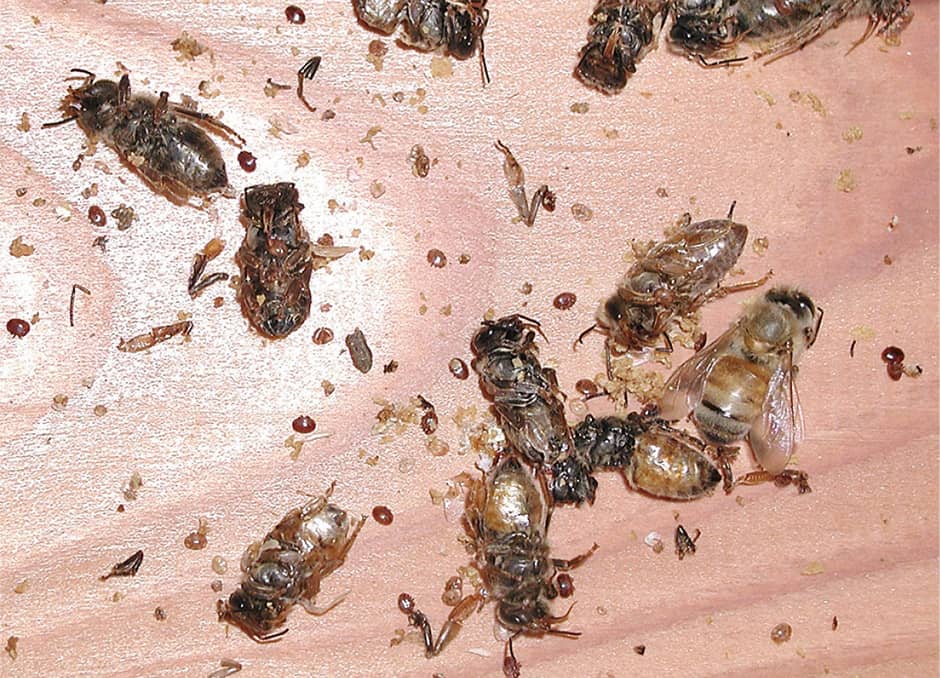
Figure 5. Bees in the terminal stage of varroosis, caused by varroa mitesVarroa mites proliferate as they feed on the pupae of worker bees and drones. Numerous mites and corpses of worker bees that had failed to emerge due to varroosis were observed on the floor of a beehive with a rampant mite infestation.
With regard to climate, there are concerns that, as global warming progresses, plant diversity will be lost, with ecosystems skewed toward only flowers that can withstand high temperatures and dry conditions. Furthermore, people are worried that rising atmospheric concentrations of carbon dioxide will reduce the protein concentration of pollen, with a consequent impact on the quality of honeybees’ food. If the protein content of pollen falls, there is a risk that honeybees could become undernourished, even if they collect the same weight of pollen, which could make it even harder to increase the honeybee population than it is now.
To ensure we can keep enjoying the blessings of honeybees forever, we must give more thought to creating an environment in which honeybees can live healthy lives.


